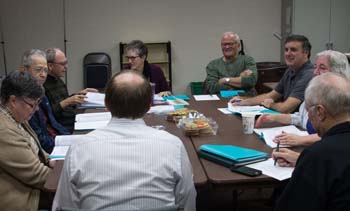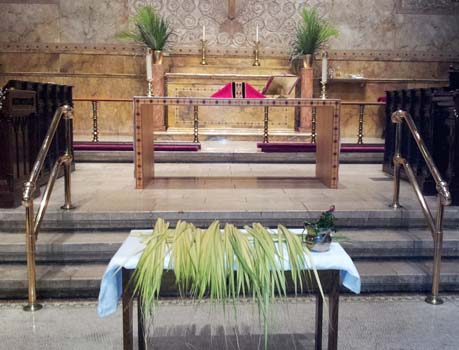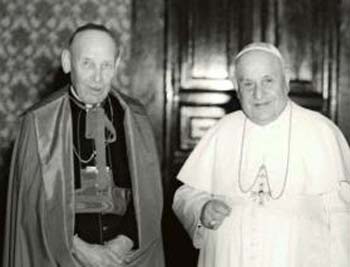Can someone explain simply the differences between the traditional Latin Mass (that I attend at St Michael's parish here in Spokane, WA) and the John XXIII Mass?
I do not think anyone here knows what missal they use at your chapel, so I don't see how they can answer you in detail, which I assume is what you want, detail.
The changes of John XXIII in the 1962 missal were minor compared to the changes of Pius XII of the 1955 missal. Up to the 1955 missal, as far as I can check, 1850, (that's the oldest missal I have) there are no changes up to the Pius XII changes. After 1955 practically every year there were more changes, the 1962 was just another year of change, then the 1965 changes, then finally the 1969 Novus Ordo.
I assume your Spokane group uses the pre-1955 missal, the changes that took place in 1955 are big. It not only involves the missal it also involved many other aspects of the priestly life, it was the beginning of the "slow boiling" of Catholics toward to Novus Ordo. Traditioninaction.com has volumes of material on the subject. Here's one:
Dialogue Mass - XLV
Revolutionary Nature of the Liturgical Reform
Dr. Carol Byrne, Great Britain
We have seen
some, but by no means all, of the depredations (1) inflicted on the Palm Sunday liturgy, which became operative in 1956, and have noted that they were undertaken at the expense of authentic Catholic values, doctrinal integrity, poetic beauty and appreciation of the Church’s past achievements.
History has indeed shown that these reforms were not only the tip of the iceberg of an unrestrained pillaging and ransacking of the ancient Holy Week rite; but they were also the first steps in a deliberate attempt to demolish our common heritage and usher in an entirely new kind of liturgy ‒ one that has not advanced the cause of Catholicism. It was a painful record of humiliation, defeat and loss for all the Bishops, priests and lay people who protested to the Holy See at the time. They were simply left to rail in impotent anger.
Given the historical evidence, we are entitled to conclude that, in spite of protestations of good intentions by the liturgists, the reforms involved either an indifference to the nature of Catholic Tradition or a desire to eradicate it.
One innovation begets another…
It is only when the details are examined that the revolutionary nature of the reforms becomes apparent. Now we shall see what new ideas were dreamt up by the progressivists to replace what they had managed to purloin from the universal Church with the complicity of Pius XII.

Pius XII opened the door to today’s liturgical committees that design liturgy for each parish
The foremost issue was the “active participation” of the people, as Fr. Frederick McManus, a major figure in the reform, explained as soon as the new Holy Week
Ordo was issued in 1956:
“The rubrics of the
Ordo refer constantly to the responses to be made by the members of the congregation and to their activity in the carrying out of the holy liturgy. This is of course a notable departure from the rubrical norms of the Roman Missal.” (2)
What is even more revolutionary is that responsibility for carrying out the liturgy now falls,
by papal diktat and for the first time in the Church’s History, on the shoulders of the laity: their “active participation” is “made a matter of rubrical law and incorporated into the very text of the new liturgical book.” (3)
When has the Roman Missal ever laid down rules to regulate how the faithful should respond during the liturgy? (4) Even Fr. McManus had to admit that the traditional Missal was silent on the manner of lay participation. But the reformed Missal, on the other hand, made it incuмbent on the laity to give the responses and contribute actively to the performance of the liturgy.
This shows that Pius XII imposed these changes in an authoritarian, oppressive and intrusive program to please the liturgical reformers. The impression was given that anyone praying silently in the pews during liturgical ceremonies would be guilty of breaking a law laid down by the Pope. (5)
The ‘cult of novelty’ in the Palm Sunday liturgy
The 1956 and 1962 Palm Sunday liturgy opens with a visual and (literally) shocking reversal of traditional practice. In order to reinforce the “community celebration” aspect, a portable table is set up in the sanctuary, the palms are laid on it and the priest blesses them in full view of the people, (6) all the while with his back to the altar and the Blessed Sacrament.

Palms setout before a bare altar at a modern
Novus Ordo church
Reversing centuries of liturgical tradition, the 1956
Ordo of Palm Sunday mandated that the priest (or deacon) should conduct an audible dialogue with the people while facing them. This took place at various points: before the blessing of the palms; (7) both before and after the procession; (8) before the Gospel and at the
Orate Fratres. (9)
Ironically, the procession in honor of Christ the King was revamped to exalt the role of the people in the liturgy. Now that the supernatural significance of the sub-deacon’s role was eliminated, as were the traditional purple vestments – doubly significant as the color associated with royalty and Christ’s Passion – the way was open to enlarging the role of the laity.
Whereas in the traditional Missal the singing of the liturgy was the function of the priest and cantors alternating with the choir, in the new
Ordo this suddenly became the responsibility of all. (10) Thus, the congregation was required to sing not only during the blessing and procession of palms, but also throughout the entire Palm Sunday Mass. (11) This introduced a novelty into the rubrics for sung Masses. The
Graduale Romanum issued by Pius X had not included instructions for congregational singing. (12)
A made-up prayer
Now, let us consider another innovation in the Palm Sunday liturgy that was incorporated into the 1962 Missal, having been first introduced into the 1956
Ordo: The prayer after the procession, which is said facing the people and to which they have to respond aloud. It was the result of a shambolic committee-work hastily cobbled together by Bugnini and his associates and was problematic for two reasons.
First, theologically speaking, the prayer was vague and ambivalent. It mentioned palm branches and God’s blessing, but without establishing any intrinsic link between them, and spoke of our redemption being wrought by Christ’s “right hand” (a phrase normally attributed to the Father).
Second, linguistically speaking, it was expressed in somewhat garbled Latin. Judging by its varying translations, no one seems to know what exactly the prayer was supposed to mean. Evidently, the composers of the prayer have left everyone guessing.
The Bea Psalms – from optional to mandatory
An example of an unwarranted intrusion into the Palm Sunday liturgy – indeed into the whole of the 1956 Holy Week ceremonies – was the imposition of a new Latin version of the Psalms, which had been undertaken, at Pius XII’s request, by a committee of biblical experts headed by Fr. Augustin Bea, S.J.

Bea would take the liturgical reform further under his friend John XXIII
This replaced St. Jerome’s Vulgate version of the Psalms that had been established as the universal and immemorial customary
lex orandi (law of prayer) for the Latin Rite. Their authenticity was guaranteed by the Council of Trent on the basis of centennial custom, which is why the liturgical use of the Vulgate was regarded as sacrosanct, as we can see from the same Council’s warning that “no one is to dare, or presume, to reject it under any pretext whatever.” (13)
At first, it was only optional, (14) but in 1956 Pius XII integrated some of the new Psalms by force of law into the Holy Week ceremonies, an initiative that was nothing short of revolutionary. This innovation was yet another example of how Pius XII subordinated immemorial Tradition to papal authority on the basis of the subjective opinions of the reformers, in a manner that would be adopted by Paul VI on a comprehensive scale.
His reform gave rise to two major problems.
First, the new wording of the Bea Psalms, drawn from Classical Latin vocabulary and syntax, was different from the “Christianized” idiom of the Vulgate, which the Church had adopted as the sacred language of the liturgy and which the clergy had been using for over 15 centuries.
Fr. Bea despised the Latin recited by the clergy for so many centuries and unjustly called it a “decadent usage” incapable of meeting the standards of Classical Latin. (15) But there was no need to have an inferiority complex about it.
As various classical scholars have shown, Medieval Latin was a direct descendant of the literary, learned Latin of the classical age, not a debased or corrupt form of it. It was this elevated form of Latin that the Church elaborated and adapted for use in Scripture and the liturgy, adding her own distinctive style and diction, to express the Christian message. And, so, there emerged the unique “Christianized” Latin that is found in the Vulgate. There the “family lineaments” of Latin Christianity are clear, revealing the Bea version as an interloper.
Second, the Bea Psalms were ill adapted to Gregorian chant, making it awkward to sing in religious communities and providing a disincentive for them to do so. (16) The words were not, in general, those used by their forebears in the Faith and the new chants, which had to be composed to match, were not those that had echoed around the medieval monasteries. We can conclude that the new Holy Week ceremonies were not in harmony with the ancient Latin liturgical heritage and should have no place in the
Roman Missal.
Thus, we can see how Pius XII began a process that had the gravest possible implications for future changes in the liturgy – the gradual detachment of the clergy from the worship, theology and spirituality of their Latin patrimony.